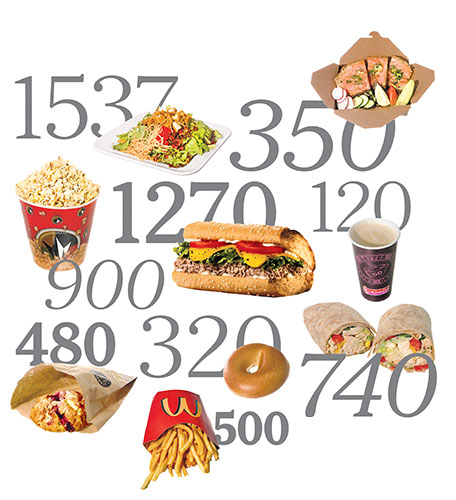
By: Kathleen Wilson
According to Section 4205 of the Affordable Care Act, restaurants with 20 or more locations must provide on their menus the number of calories in each menu item. These regulatory measures largely affect regional and national fast food chains that have many different locations. Furthermore, the number of calories must also be listed for self-service foods such as food sold through salad bars, cafeteria lines, or buffets. Additionally, vending machines must also display the caloric amount of each article of food in a clear and conspicuous manner. A date for enactment of this policy has not been set; however, once enacted, these regulations will be monitored by the U.S. Food and Drug Administration. The goal of this provision of the Affordable Care Act is to prevent obesity by making consumers more aware of their caloric intakes. But is putting calorie counts on menus a feasible way to attack this modern day pandemic, and will it change consumer behavior?
The act’s provision fails to take into account the feasibility of listing calories alongside every menu item in restaurants and fast-food enterprises. For instance, Domino’s Pizza claims that when factoring in all of the different crust and toppings combinations, it offers more than 34 million different pizza combinations. An online calculator could allow customers to customize their pizza and receive an overall caloric estimate, but this would not satisfy the demand that caloric values be printed directly on menus. The FDA has suggested that restaurants’ menus offer a calorie range for different pizza options, but has not given guidance on specific calorie range values. As another alternative, pizza restaurants could include the calorie count per one serving of each possible topping on their menus, allowing customers to calculate their individual calorie estimates. However, would the average consumer take the time to actually perform these calculations?
The American Pizza Community has become a prominent voice in opposition to Section 4205; however, this argument extends beyond just pizzas. For example, Chick-fil-A lists its Cobb Salad as containing 430 calories. This calculation, however, does not include the caloric estimate for a serving of the salad’s suggested Avocado Lime Ranch Dressing: 310 calories. So, if someone buys this salad and uses all of the dressing in the packet provided, the total caloric amount of the salad is 740 calories. What if only half of the dressing is used? What if a customer decides to order the salad without the cheese; how many calories does that subtract? Chick-fil-A could list a range of caloric amounts for its salad (430-740), but this would take up more space on an already cramped menu. Section 4205 does not require that menus include calorie amounts with such a degree of specification, but its goal is to make consumers more aware of their calorie intakes and thus prevent obesity, how effective is it to simply list the information about a basic salad? If anything, this exclusion of the salad dressing in this case gives consumers a false, underestimated calorie count.
Furthermore, the question remains: will any of this actually change consumer behavior? A study conducted by the New York University Lagnone Medical Center found that calorie counts on menus are often ignored by consumers and do not have a significant impact on the healthiness of the orders placed. In a survey of more than 2,000 patrons of Burger King and McDonald’s in Philadelphia, only 49 percent of Burger King patrons and 34 percent of McDonald’s patrons noticed the calorie labeling. The study also found that only 10 percent of study participants responded that the calorie labels influenced their food choice. This study is important because fast-food is eaten disproportionately by low-income people who are also the part of the population most likely to be overweight. If the focus of Section 4205 is to prevent obesity, the NYU study suggests that calorie count labels will not have a sizable impact on changing the behavior of those consumers most prone to being overweight.
Individuals with low incomes who frequent fast food establishments may be more responsive to price than to calorie labeling. The American Journal of Public Health reported that a 10 percent increase in fast-food prices yielded an 8.1 percent reduction in consumption. Thus, one under budget constraints would be more likely to buy the $2 Bacon McDouble (460 calories) than the $5 Southwest Salad with Grilled Chicken (290 calories)because even though a salad may be healthier, its high price would make it prohibitive to purchase. Moreover, low-income individuals with poor math skills would be more likely to simply buy something with a lower price than to examine calorie counts and calculate how much the calories in one food would contribute to the daily recommended value of calories.
The mandate that menus contain calorie counts is unfeasible for small businesses and largely ineffective in changing consumer behavior. If the goal of the FDA is to prevent obesity by increasing labeling on menus, a color-coding system could be a more feasible solution. An Oklahoma State University study found that a traffic light labeling system—green lights for foods fewer than 400 calories, yellow lights for 401-800 calories, and red lights for foods over 800 calories—has a much greater effect on encouraging consumers to choose lower-calorie options than menus with calorie counts. A similar study done as Massachusetts General Hospital found that after six months, the number of red, unhealthy items purchased decreased by 20 percent, while green purchases rose by 12 percent. Furthermore, the United Kingdom Department of Health has decided to implement a national color-coding on food labels by December 2014; this system will color-code not only calories but also fats, saturates, sugars, and sodium. Such color-coding systems allow for consumers to make quick, visual decisions without making mathematical calculations. Furthermore, they benefit businesses by being cheaper to use and easier for including ranges instead of exact numbers. A color-coding system in combination with a comprehensive online calculator that provides both caloric information and other nutritional information (fats, carbohydrates, sodium), has the potential to be most beneficial for the FDA, producers, and consumers.

